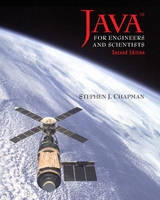
Java for Engineers and Scientists
Pearson (Verlag)
978-0-13-919523-5 (ISBN)
- Titel erscheint in neuer Auflage
- Artikel merken
For courses in Java Programming Language, and Structured Programming Techniques.
From the very beginning, this concise introduction to Java develops and executes practical examples useful for solving problems in an engineering environment. Focused on the proper way to write reliable Java programs, it outlines excellent software development practices; uses a top-down design technique to break the program up into logical portions; and demonstrates object re-usability by building later examples on the classes and methods created in earlier examples. The text makes learning an interactive experience by providing all sources for all examples through a Website.
The book also includes a number of supporting classes to make it easier for engineers to format numbers in Java, to display data in linear or logarithmic plots, to work with complex numbers, to manipulate arrays, and to perform such common engineering calculations as FFTs, convolutions, correlations, etc.
STEPHEN J. CHAPMAN is an Electrical Engineer with a specialty in Digital Signal Processing and Radar Systems. His career has included more than 20 years of experience writing large programs in Defense and Seismic Signal Processing environments. His projects have included real-time radar programming for M.I.T.'s Lincoln Laboratory; developing seismic signal processing algorithms for Shell Oil Company and large simulation programs for British Aerospace Australia. He has taught Electrical Engineering and Electrical Technology Programs at the University of Houston and Computer Science in the Pacific Division of the University of Maryland. STEPHEN J. CHAPMAN is an experienced author with several books already to his credit, including his first book with Prentice Hall, an E-Source title, Introduction to Java.
1. Introduction to Java.
2. Basic Elements of Java.
3. Branches and Program Design.
4. Repetition Structures.
5. Arrays, File Access, and Plotting.
6. Methods.
7. Classes and Object-Oriented Programming.
8. Exceptions and Complex Numbers.
9. Inheritance, Polymorphism, and Interfaces.
10. Strings.
11. Introduction to Java Graphics.
12. Basic Graphical User Interfaces.
13. Additional GUI Components and Applets.
14. Input and Output.
Appendix A: ASCII Character Set.
Appendix B: Operator Precedence Chart.
Appendix C: Answers to Quizzes.
| Erscheint lt. Verlag | 16.9.1999 |
|---|---|
| Sprache | englisch |
| Gewicht | 1030 g |
| Themenwelt | Informatik ► Programmiersprachen / -werkzeuge ► Java |
| Mathematik / Informatik ► Informatik ► Web / Internet | |
| ISBN-10 | 0-13-919523-8 / 0139195238 |
| ISBN-13 | 978-0-13-919523-5 / 9780139195235 |
| Zustand | Neuware |
| Haben Sie eine Frage zum Produkt? |
aus dem Bereich



